Ski Resort Industry Overview
In the US, the Ski Resort Industry is consists of over 300 companies, generating roughy $4 Billion in annual revenue. Aside from selling lift tickets and season passes, ski resorts generate revenue through their associated hotels, restaurants, bars, and other attractions. This analysis will focus on strategies for managing revenue from ski mountain lift ticket and season pass sales. Also, most ski mountains supply of space exceeds the demand that would be needed to reach “capacity” at a given time
Space
The size of a ski area is typically expressed as number of skiable trails or in total acres. The skiable area is an explicitly defined space which customers rent for use. Purchasing a lift ticket or season pass entitles the purchaser to use the space for a specified time, but the space is shared among all patrons utilizing the space at a given time. In order to maintain safety and in some cases to provide the luxury of limiting lift lines, space capacity can be considered fixed. On the other hand, many resorts have difficulty predicting demand due to its corellation with the weather, which can result in long lift lines, and crowded slopes.
The overall space can be categorized by skiing terrain, ski lifts, maintenance areas, F&B Outlets, retail and equipment shops, lodging, and ticket sales. The Skiing Terrain space at most ski resorts is divided into trails which follow a rating system ranging from beginner to expert terrain, as shown below.
The terrain of a ski mountain is mostly determined by the natural slope, along with obstacles and snow conditions.
The following trail maps are examples of how ski resorts manage their space:
1.Greek Peak Ski Resort, Cortland, NY

2.Park City Mountain Resort, Park City, Utah
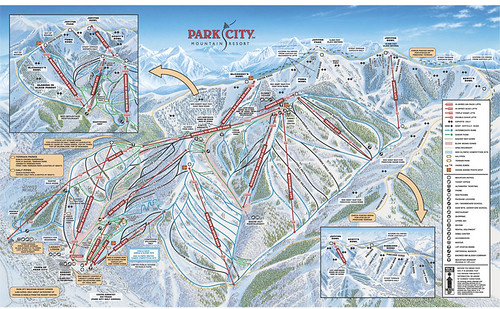
3. Heavenly Ski Resort, South Lake Tahoe, CA

4. Vail Mountain, Vail, CO

Additional Revenue
Aside from lift ticket sales, Ski resorts are able to generate substantial revenue through their on-mountain rental programs, F&B outlets, retail stores, and other attractions.
Some examples:
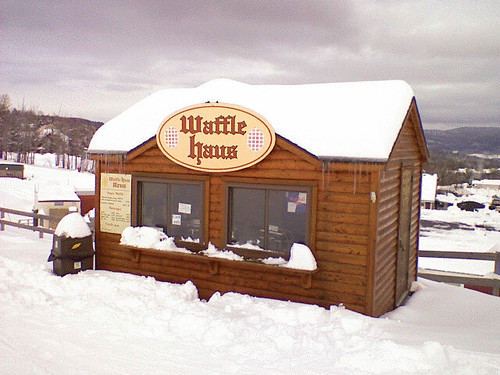
Waffle Haus at Sugarbush, Utah
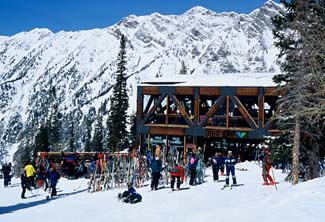
Mid-Mountain Lodge at Alta, Utah
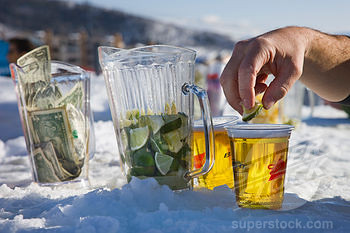
Ice Bar at Steamboat, ColoradoSki Lesson at Heavenly, Lake Tahoe
Some creative ideas on how ski resorts can increase revenue:
- Offer hot beverages next to lift queue
- Install camera coverage throughout mountain and sell videos
- Create a first-class section of the mountain with well maintained conditions and limit the quantity of tickets sold (physical rate fence)
Time
Ski resorts sell time explicitly, due to limited hours of lift operation, which is usually during the day, sometimes at night with lights. Traditional Season Passes allow for unlimited use of the mountain terrain during operating hours. Many resorts are now offering passes that can be used on certain days, or for a specified number of days per season. Lift tickets are normally sold for an entire day(8 hour), multiple consecutive days, half day, or hourly. Holiday Valley is an example of a resort that offers flexible lift tickets, meaning that if you buy a half-day (4 hour) pass, the 4 hours begins when you board the first lift. Greek Peak, on the other hand only offers half day passes that begin after 3 PM, which may limit their potential to attract customers during slow off peak week day mornings. In order to increase demand, many resorts also offer reduced rate beginner only lift tickets that are good for a limited number of lifts servicing beginner terrain. A creative approach to the current method of offering beginner only lift tickets would be to offer intermediate or expert only tickets. The big issue with such a division of space would be monitoring and regulating the different types of passes. It also may be less attractive for people within groups, but if the trails had physical barriers there may be an opportunity to increase revenue by offering access to expert terrain only at a reduced rate, which could attract back-country skiers who may be more price sensitive than a family on vacation.
Price
Non-physical rate fences are used by most Ski resorts to determine lift ticket and season pass rates. Some resorts have created Physical rate fences to maximize revenue, mostly through learn to ski/ride programs which include a lift ticket that is limited to beginner trails. Some non-physical rate fences used include:
1. Age
2. Student
3. Military
4. Local Resident
5. Rewards program member or season pass holder discounts
The Canyons resort in Park City, Utah offers all of the above listed rate fences and many more, which include teachers, honor role students, local students, police, and firefighters.
The following Lift ticket and season pass rates illustrate how resorts have set non-physical rate fences:
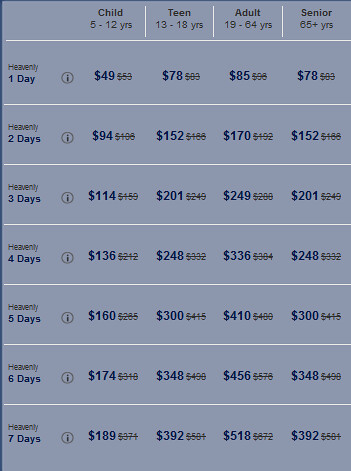
Heavenly Lift Ticket Rates

Greek Peak Lift Ticket Rates

Killington Season Pass Rates
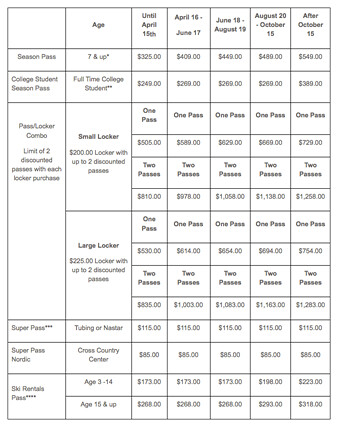
Greek Peak Season Pass Prices
The lack of physical rate fences is due to the unconstrained space and a lack of barriers to separate areas that could be sold individually. If resorts want to create more physical rate fences, they would need to devote a lot of resources to build barriers and monitor traffic between the different areas. As you can see in the Greek Peak rates above, they offer a discounted daily rate for chair 3 only, due to the fact that it has parking lot access and a variety of trails. At larger resorts, the use of physical rate fences or a pay-per-use system may be feasible, but I think customers would be weary to be charged every time they want to ski down a trail on a per run basis. It’s also difficult to analyze the value and popularity for each run if such a system were to be implemented, due to limited technology. However, many resorts scan passes and tickets at the lift line, which could be further analyzed to determine not only demand by time of day or week, but by location.












equipment shops, lodging, and ticket sewa mobil ke bandara ski resorts is divided into trails which follow a rating system ranging
スロット オンラインスロットマシン ーストラリアン オンライン ポーキーは、オーストラリアで人気のあるギャンブルの形式です。これらは全国のパブ、クラブ、カジノで見つけることができます。スロットマシンは、明るい光、魅力的な音、そして多額の賞金を獲得する可能性のあるスリルで知られています。アクセスのしやすさと、それが生み出す興奮により、多くのオーストラリア人にとってお気に入りの娯楽となっています。しかし、この広範な人気は、問題のあるギャンブルやそれに伴う危害など、重大な社会的および経済的問題も引き起こしています。ポーキーの影響を規制および管理する取り組みには、最大賭け金の制限、強制休憩の導入、ギャンブル依存症に苦しむ人々への自己排除プログラムの提供などの措置が含まれます。近年、オンラインカジノの台頭により、オーストラリアのギャンブル環境に新たな側面が加わりました。オンラインカジノでは、自宅から快適にアクセスできる仮想スロットゲームを含むさまざまなゲームを提供しています。オンライン ギャンブルのポーキーの利便性と匿名性により、ますます多くのプレイヤーが魅了されています。しかし、これはまた、従来の会場の物理的制約がなければ個人が過剰なギャンブルをしやすくなるため、問題のあるギャンブルが増加する可能性についての懸念も引き起こしています。オーストラリア政府は、無認可の運営者の禁止やより厳格な広告ガイドラインの導入など、オンラインギャンブルに関する規制を強化することで対応した。これらの措置にもかかわらず、オンラインスロットマシン の人気は高まり続けており、楽しみと責任あるギャンブルの実践のバランスを取るための継続的な取り組みの必要性が浮き彫りになっています。
Gratitude for your post. I’ve been contemplating composing an entirely similar post over the most recent few weeks, I’ll likely keep it quick and painless and connection to this all things being equal if that is cool. Much appreciated. Betgaranteed
I am happy to find it. It’s a great post. สมัคร huaybee
There are a few paper sites online on the grounds that you buy clearly with their realized inside site. stsfor.org
Use of paper url pages supported by the internet at the time you transformed into just discussed as a feature of your page. brainmarc.com
This content is composed well indeed. Your utilization of arranging while coming to your meaningful conclusions makes your perceptions exceptionally understood and straightforward. Much thanks to you. grandprixtournaments.com
This data is superb. I get it and regard your obvious focuses. I’m dazzled with your composing style and how well you offer your viewpoints. growlanser-realm.com
At the point when a visually impaired man bears the standard pity the individuals who keep… . Where obliviousness is happiness ’tis indiscretion to be shrewd… . carcassonne-online.com
Howdy! Somebody in my Myspace bunch imparted this site to us so I came to give it a look. I’m certainly adoring the data. I’m bookmarking and will tweet this to my adherents! Extraordinary blog and magnificent style and plan. andaluciadiversa.com
Wow this hit it to the spot we will bookmark on Bebo and also Hub pages thanks ГородÑкую комиÑÑию по землепользованию Ñменил МоÑинвеÑтконтроль | ПрофеÑÑиональные новоÑти | ООО “Белго+” – Двери производÑтва БелоруÑи. Продажа, уÑтановка love it And also my prayers to the people at atomic plant we hope you are OK along with safer too !!! Kudos Financial Advisers theredpillednews.com
나는 이것을 읽을 것이다. 다시 올게요. 공유해 주셔서 감사합니다다 .. 무료 스포츠중계
“이것은 훌륭한 기사입니다. 많은 정보를 감다. 무료 스포츠중계
I think this is among the most vital info for me. And i’m satisfied studying your article. However should commentary on few normal things, The website taste is ideal, the articles is in reality excellent . Excellent activity, cheers. Eaton Distributor
I think this is among the most vital info for me. And i’m satisfied studying your article. However should commentary on few normal things, The website taste is ideal, the articles is in reality excellent . Excellent activity, cheers. Eaton Distributor
Some resorts have created Physical rate sewa double cabin bandung revenue, mostly through learn to ski
Also, most ski mountains sewa hiace bandung supply of space exceeds the demand that would be needed
use the space for a specified time, but the sewa mobil drop off the space at a given
First You got a great blog .I will be interested in more similar topics. i see you got really very useful topics, i will be always checking your blog thanks.
Wow, great stuff. I have been considering this for a few years. I’m glad to seemingly find someone that comes to the same conclusions as me. At least it seems that’s the case. I’ll keep visiting your site to stay informed. acim
Regards for all your efforts that you have put in this. Very interesting information. acim
I’ve recently started a web site, the information you offer on this site has helped me greatly. Thanks for all of your time & work. acim
When intending to raise หวย a cat or pet That means time and love.
Nothing compares to Weber using Genesis sort of grills. That is certainly the type gas grills which have been that will always make sure that they deliver a high performance part of down interval
from this summer camp, and แอพคาสิโน I will forever
Oh my goodness! a great post dude. Thanks a ton Nevertheless I’m experiencing trouble with ur rss . Do not know why Struggle to enroll in it. Could there be any person obtaining identical rss dilemma? Anybody who knows kindly respond. Thnkx Bathroom Renovations in Box Hill
I’m thrilled to share my recent experience with SEVlaser! After reading so many positive reviews here, I knew I had to give it a go. Just after our engagement, I wanted to do something special and exciting for myself, so I booked a session for Laser Hair Removal in Philadelphia as a treat. The service was fantastic, and the results have been amazing. It was a wonderful gift to myself, and I’m so glad I did it. Thanks for the great advice and the glowing reviews from everyone!
https://trello.com/u/dakake6478
managing revenue from ski rental mobil double cabin bandung. Also, most ski mountains supply
After study several of the blogs with your website now, i truly much like your strategy for blogging. I bookmarked it to my bookmark web site list and will be checking back soon. Pls look at my internet site at the same time and make me aware if you agree. fantasy name generator
Hi there, of course this piece of writing is really pleasant and I have learned lot of things from it about blogging. thanks.
시알리스 처방전 없이 구입
Your writing is so relatable and down-to-earth It’s like chatting with a good friend over a cup of coffee Keep sharing your wisdom with us
I truly admire how you tackle difficult topics and address them in a respectful and thought-provoking manner
비아그라 구입
Your writing is so relatable and down-to-earth It’s like chatting with a good friend over a cup of coffee Keep sharing your wisdom with us
비아그라 구매
by skiing terrain, ski lifts, maintenance sewa hiace murah bandung Outlets, retail
Thank you for contributing to the body of knowledge in [field or industry]. trang web cá cược bóng đá hợp pháp
It’s really good and helpful information. I guess I’m not the only one happy here. Thank you very much.
123bet สล็อต
I appreciate you offering such lovely items. I learned something from your blog. Continue sharing
ทาง เข้า หวย ลาว
Hi there, I found your blog via Google while searching for such kinda informative post and your post looks very interesting for me.
Ingin top up game dengan cepat, aman, dan harga terjangkau? MOONCASH adalah jawabannya. Sebagai platform top up game terpercaya di Indonesia, Mooncash menawarkan berbagai pilihan game dengan harga yang kompetitif. Proses top up yang sederhana dan dukungan pelanggan yang responsif membuat Mooncash menjadi solusi terbaik bagi para gamer yang menginginkan layanan berkualitas tinggi tanpa menguras dompet.
Great breakdown of ski resort space and revenue management! Balancing lift ticket sales, terrain, and weather demand is key. Greek Peak’s trail maps illustrate effective space utilization. Thanks for sharing! DDP Services
resorts is divided into trails which sewa mobil drop off a rating system ranging from beginner to expert terrain, as shown
It also allows you to add optional covers like personal accident cover, zero depreciation, etc.
https://www.gintejainsurance.com/bike-insurance
resorts is divided into trails which rental mobil tahunan ranging from beginner to expert terrain, as shown
most ski mountains Tagline Brand supply of space exceeds the demand that would be needed
Extremely pleasant article, I appreciated perusing your post, exceptionally decent share, I need to twit this to my adherents. Much appreciated!.
lush and greenery. I love 11hilo spending time
If you want a way to wake up early to 123 be effective in the long run.
Impressive web site, Distinguished feedback that I can tackle. I am moving forward and may apply to my current job as a pet sitter, which is very enjoyable, but I need to additional expand. Regards
Start Streaming: After selecting the event, you’ll be directed to the live stream. Simply click play, and you can start watching the game in real time. 네네티비 바로가기